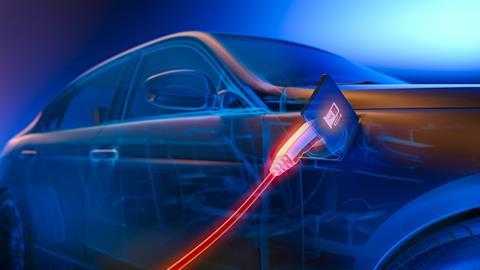The appeal of electric vehicles is on the rise - as are the numbers of these cars on the roads – but a lack of data and expensive repair costs are testing the industry’s response
At the start of 2020, just 0.7% of cars in the UK were electric vehicles (EVs), according to vehicle research centre Thatcham Research. However, that figure is rising rapidly and the insurance industry is having to accelerate its ability to meet the needs of policyholders.
For example, automotive organisation the RAC estimated that as of April 2021, the UK had around 239,000 zero emission, battery operated EVs on its roads, as well as 259,000 plug-in hybrid vehicles and 629,000 conventional hybrid cars.
Steve Molloy, director of commercial sales at accident aftercare specialist AX, said insurers are already finding that there are fundamental challenges for the insurance market when it comes to dealing with EVs.
One such issue, for example, is that “EVs are all deemed to be performance vehicles given the way in which their motors operate” Molloy explained.
Therefore, one of the biggest concerns for insurers is the stark difference in acceleration between an EV and an internal combustion engine (ICE) vehicle.
Unlike an ICE, power to an EV is immediate, so acceleration is faster – this brings concerns over drivers’ ability to safely operate EVs.
Stephen Clery, commercial motor manager at Allianz Insurance, said acceleration was an issue, but it was a short-term threat.
“Electric vehicles have stronger acceleration than petrol or diesel vehicles,” he explained.
“Drivers’ initial lack of familiarity with this feature can lead – temporarily – to a higher risk of injury and damage to third parties. The risk diminishes once they adjust their driving style to their electric car’s performance characteristics.
“With charge and performance being directly related to driving style, there is a possibility over the long term that EV drivers may turn out to be more conscientious than other road users.”
Marc Wanless, head of corporate motor at Aviva added: “The acceleration in EVs reaffirms our view of the requirement for driver education.
“There needs to be a system in which owners or drivers of EVs are made aware of the difference in performance and are provided with a level of training.”
Impact on repairs

While the threat to the insurance market from the performance of EVs is an issue already, it is also becoming apparent that there are challenges around the repair of electric vehicles.
Molloy said the average cost of an ICE vehicle repair is £3,000, but for EVs that figure increases to £4,000.
The lack of expertise at repair facilities, the time it takes to carry out a repair and the cost of parts is seeing EVs written off for repairs that would typically be carried out on an ICE vehicle.
David Williams, managing director of underwriting and technical services at Axa Insurance UK, said: “With the car battery representing such a large proportion of the vehicle value, with the potential that it could be written off, even when subject to relatively little damage and with little salvage opportunity, the risk profile [of EVs] can be quite different.
“On top of the risks associated with the physical vehicle parts, we must also understand the driver - how they use their car and for what type of driving.
“It is also important to remember that alongside the change in power, electric vehicles are often fitted with the latest driver assistance technology, which - whilst impacting the cost of individual repairs - can have a marked impact on reducing claims frequency.”
Clery added that he expects EV “repairs to become more expensive to begin with”.
He continued: “Garages will need specific equipment, such as insulated tools and mats and voltage testers. In addition, their mechanics will require new skills. This additional training could push labour rates up.
“It might take more time and more parts to repair an electric vehicle and another element that will have a major impact is the material being used to manufacture some EVs - carbon fibre is expensive.
“However, with more electric vehicles hitting the roads, we expect all these trends to recede and [for] repair costs to normalise over time.
“For claims, electric batteries are not that tricky - battery cost remains high but unless an EV is involved in a severe accident, it is unlikely that the battery will need to be replaced.
“Also, contrary to popular belief, electric vehicles are no more likely to be involved in a fire than internal combustion engine vehicles.”
Accommodating new technology
Thatcham Research has been exploring topics around EVs for some years now. Adrian Watson, the company’s head of engineering research, said while differences remain between EVs and ICE vehicles, these should not be seen as significant if the right training and approach is taken.
He explained: “We have seen a huge increase in the interest from insurers as the number of EVs continues to grow.
“[There is a] lack of data [around EVs] so we have been working with the industry to look to how we can help insurers fill in the gaps.
“Like any new technology, there will be a learning curve but as long as those throughout the repair process understand the need to identify EVs and adopt different approaches to safety and the repair process, the repairs can be carried out.
“We would expect that in the future, with the right training, that EV repairs will be seen as part of the daily routine.”
Williams added: “Electric vehicles are still a relatively new addition to the motor market and, as with all new technologies, they come with their own set of challenges that must be taken into consideration when underwriting their risk.
“For example, we must reflect the need for specific repairs, the need for specialist bodyshops and their cost in our policies and pricing.
“At this point, whilst take up of these vehicles is still relatively low, there is limited claims data available, meaning that we are more likely to see increased volatility in claims costs and pricing in the early days.”













































No comments yet